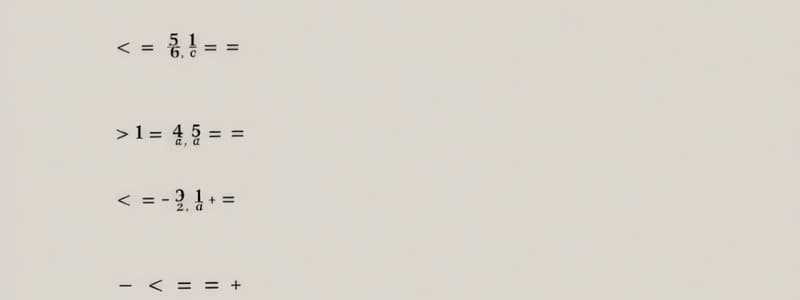Podcast
Questions and Answers
Which operation is used to simplify algebraic fractions?
Which operation is used to simplify algebraic fractions?
- Addition
- Division
- Reduction to lowest terms (correct)
- Multiplication
What is the solution to the simple equation $x + 5 = 10$?
What is the solution to the simple equation $x + 5 = 10$?
- x = 5 (correct)
- x = 2
- x = 15
- x = 50
Which symbol represents 'less than or equal to' in linear inequalities?
Which symbol represents 'less than or equal to' in linear inequalities?
- <
- $\leq$ (correct)
- =
- >
What is a polygon with four sides called?
What is a polygon with four sides called?
What does a scale drawing represent?
What does a scale drawing represent?
Flashcards
Algebraic Fraction
Algebraic Fraction
A fraction where the numerator and/or denominator contain algebraic expressions.
Simple Equation
Simple Equation
A mathematical statement showing the equality between two expressions.
Linear Inequality
Linear Inequality
A statement showing that one expression is greater than, less than, or equal to another expression.
Plane Shapes
Plane Shapes
Signup and view all the flashcards
Scale Drawing
Scale Drawing
Signup and view all the flashcards
Study Notes
- JSS2 Mathematics Second Term Curriculum in Nigeria covers: algebraic fractions, simple equations, linear inequalities involving one variable, plane shapes and figures, angles in a polygon, scale drawings, graphs, and angles of elevation and depression.
Algebraic Fractions
- Focuses on simplifying, adding, subtracting, multiplying, and dividing fractions involving variables.
- Understanding how to find a common denominator is crucial for addition and subtraction.
- Simplifying fractions often involves factoring and canceling common factors.
Simple Equations
- Deals with solving equations that contain one variable.
- Uses addition, subtraction, multiplication, and division to isolate the variable.
- Emphasizes the importance of performing the same operation on both sides of the equation to maintain balance.
Linear Inequalities Involving One Variable
- Similar to simple equations but involves inequality symbols (>, <, ≥, ≤).
- Solution is a range of values rather than a single value.
- Multiplying or dividing by a negative number reverses the inequality sign.
Plane Shapes and Figures
- Includes identifying and understanding the properties of shapes such as triangles, squares, rectangles, circles, and parallelograms.
- Calculating area and perimeter/circumference is a key aspect.
- Focuses on understanding the relationships between sides, angles, and diagonals.
Angles in a Polygon
- Covers the properties of angles within polygons, including triangles, quadrilaterals, pentagons, etc.
- The sum of interior angles in a polygon can be calculated using a formula.
- Regular polygons have equal sides and equal angles
Scale Drawings
- Involves creating accurate representations of objects or areas at a reduced or enlarged size.
- Requires understanding of scale and proportion.
- Used in map making, architectural plans, and engineering designs.
Graphs
- Focuses on understanding and interpreting different types of graphs.
- Includes bar graphs, line graphs, pie charts, and pictograms.
- Ability to extract information and make comparisons from graphical data.
Angles of Elevation and Depression
- Deals with angles formed between a horizontal line and the line of sight to an object above (elevation) or below (depression).
- Involves applying trigonometric ratios (sine, cosine, tangent) to solve problems related to heights and distances.
- Understanding right-angled triangles is essential for solving these problems.
Studying That Suits You
Use AI to generate personalized quizzes and flashcards to suit your learning preferences.




